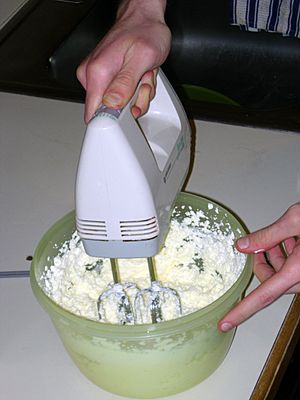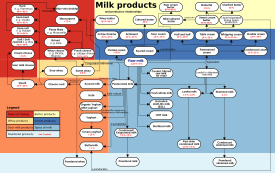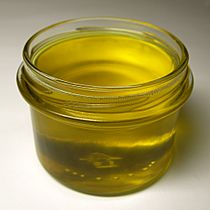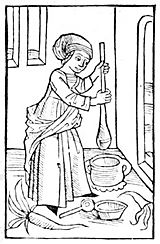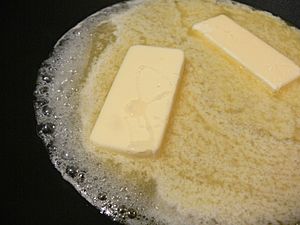Butter facts for kids
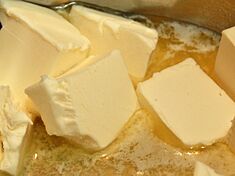
Melted and solid butter
|
|
| Nutritional value per 1 US Tbsp (14.2g) | |
|---|---|
| Energy | 101.8 kcal (426 kJ) |
|
0.01 g
|
|
| Sugars | 0.01 g |
|
11.5 g
|
|
| Saturated | 7.3 g |
| Trans | 0.5 g |
| Monounsaturated | 3 g |
| Polyunsaturated | 0.4 g |
|
Protein
|
0.1 g
|
| Vitamins | Quantity
%DV†
|
| Vitamin A equiv. |
12%
97.1 μg |
| Vitamin A | 355 IU |
| Vitamin B12 |
1%
0.024 μg |
| Vitamin E |
2%
0.33 mg |
| Vitamin K |
1%
0.99 μg |
| Other constituents | Quantity |
| Cholesterol | 30.5 mg |
|
|
|
| †Percentages estimated using US recommendations for adults. | |
Butter is a dairy product made from the fat and protein parts of milk or cream. It is a soft solid at room temperature. Butter is mostly butterfat, about 80%. People use it as a spread on bread, melted as a condiment, or as an ingredient in baking and cooking.
Most butter comes from cow's milk. But it can also be made from the milk of other animals like sheep, goats, buffalo, and yaks. It is made by shaking milk or cream very fast. This process, called churning, separates the fat from the buttermilk. Sometimes, salt and food coloring are added to butter. When butter is heated to remove water and milk solids, it becomes clarified butter or ghee. This is almost pure butterfat.
Butter is an emulsion, which means tiny drops of water are mixed into the fat. It stays firm when cold but softens at room temperature. It melts completely between 32 to 35 degrees Celsius (90 to 95 degrees Fahrenheit). Butter usually has a pale yellow color. Its natural color depends on what the animal ate. However, companies often add colors like annatto to make it look more yellow.
Contents
What is Butter?
The word butter comes from an old Greek word, bouturon. This word might mean "cow-cheese." The term "butter" usually means the dairy spread. But it can also describe other soft, spreadable foods. For example, peanut butter and almond butter are made from nuts. Apple butter is made from fruit. Even fats like cocoa butter and shea butter, which are solid at room temperature, are called "butters."
How is Butter Made?
Milk and cream contain tiny balls of fat called butterfat globules. These fat balls are covered by a thin layer of protein and fat. This layer stops the fat from clumping together. To make butter, cream is shaken or stirred a lot. This action breaks the protective layers around the fat globules. Then, the fat can join together and separate from the rest of the cream.
The way butter is made affects how firm or soft it is. This is because butter contains fat in different forms: free fat, fat crystals, and fat globules that are still whole. Butter with many crystals is harder than butter with more free fats.
When cream is churned, small pieces of butter form in a watery liquid. This liquid is called buttermilk. Today, most buttermilk you buy is fermented skimmed milk, not the liquid left from making butter. After churning, the buttermilk is drained away. Sometimes, the butter pieces are rinsed with water to remove more buttermilk. Then, the butter pieces are pressed and kneaded together. This makes the butter into a solid block and pushes out any remaining buttermilk or water.
Commercial butter is usually about 80% butterfat and 15% water. Butter made in traditional ways might have less fat and more water. Butter can go bad, or become rancid, if its fat breaks down. This gives it a strong, unpleasant smell.
Different Kinds of Butter
Before modern factories, cream was often collected over several days. This meant it was a bit fermented by the time it was made into butter. Butter made from fermented cream is called cultured butter. During fermentation, bacteria turn milk sugars into lactic acid. This process creates extra flavors, like diacetyl, which gives cultured butter a richer taste. Today, cultured butter is usually made from pasteurized cream with special bacteria added.
Another way to make cultured butter is to make butter from fresh cream first. Then, bacteria and lactic acid are added. The cultured butter flavor develops as the butter is stored in the cold. This method is more efficient for factories.
Dairy products are often pasteurized to kill harmful bacteria. Butter made from pasteurized fresh cream is called sweet cream butter. This type of butter became popular in the 1800s. Butter made from fresh or cultured unpasteurized cream is called raw cream butter. Raw cream butter does not last as long as pasteurized butter.
Cultured butter is popular in Europe. Sweet cream butter is more common in the United States and the United Kingdom. Some "spreadable" butters are made to stay softer when cold. These can be made by changing the fat in the butter or by adding vegetable oil. "Whipped" butter has nitrogen gas added to make it lighter and easier to spread.
Butter is sold in both salted and unsalted forms. Adding salt to butter gives it more flavor and helps it last longer. In the United States, butter must have at least 80% butterfat. European butters often have a higher amount, up to 85%.
Clarified Butter and Ghee
Clarified butter is butter with almost all its water and milk solids removed. It is nearly pure butterfat. To make it, butter is heated until it melts. Then, it cools, and the different parts separate. The milk proteins form a skin on top, which is removed. The clear butterfat is then poured off, leaving water and other milk solids at the bottom.
Ghee is a type of clarified butter that has been heated longer. After the water evaporates, the milk solids turn brown. This gives ghee a special flavor and helps it last longer. Ghee can be stored for six to eight months.
Whey Butter
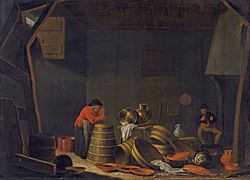
Cream can also be separated from whey, which is a liquid left over from making cheese. Butter made from whey cream is called whey butter. It has less fat and tastes more salty and "cheesy." It is also cheaper than butter made from regular cream.
European Butters
Some butters made in Europe have special names that protect where they come from. These include:
- Beurre d'Ardenne, from Belgium
- Beurre d'Isigny, from France
- Beurre Charentes-Poitou (and Beurre des Charentes and Beurre des Deux-Sèvres), from France
- Beurre Rose, from Luxembourg
- Mantequilla de Soria, from Spain
- Mantega de l'Alt Urgell i la Cerdanya, from Spain
- Rucava white butter (Rucavas baltais sviests), from Latvia
The History of Butter
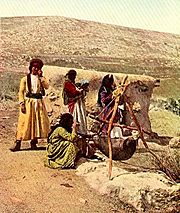
The first butter was likely made from sheep or goat milk. An old way to make butter, still used in parts of Africa and the Near East, involves a goat skin bag. The bag is filled with milk, inflated with air, and then rocked until butter forms.
In warm places like the Mediterranean, butter spoils quickly. So, ancient Greeks and Romans thought butter was a food for "barbarians" from cooler northern lands. They mostly used it as medicine.
Historians believe that many old texts talking about butter in the Near East were actually talking about ghee. Ghee has been important in India for over 3000 years. It is a symbol of purity and used in religious ceremonies. The story of the child Krishna stealing butter is a popular children's tale in India.
Butter in the Middle Ages
In cooler parts of northern Europe, butter could be stored longer. Scandinavia has a long history of trading butter, going back to the 1100s. After the Roman Empire fell, butter became a common food across Europe. However, it was mostly eaten by peasants. Over time, richer people started eating it more, especially after the Roman Catholic Church allowed it during Lent in the 1500s.
Sometimes, butter in northern Europe was buried in peat bogs. This "bog butter" would develop a strong flavor but stay edible. This was because the bogs were cool, airless, and acidic. Buried butter is often found by archaeologists in Ireland.
Butter Factories and Changes
Until the 1800s, most butter was made by hand on farms. The first butter factories appeared in the United States in the 1860s. In the late 1870s, the centrifugal cream separator was invented. This machine quickly separated cream from milk, making butter production much faster. By 1900, more than half the butter in the United States was made in factories.
Butter also gave extra money to farm families. They would press butter into decorated blocks to sell. These decorations often showed which farm made the butter.
Over the 1900s, butter use went down in many Western countries. This was mainly because margarine became popular. Margarine was cheaper and was thought to be healthier.
How Butter is Packaged
In the United States
In the United States, butter is often sold in small, rectangular blocks called sticks. These are usually 4 ounces (about 113 grams) and wrapped in paper. Four sticks are often sold together in a 1-pound (about 450 grams) package.
There are two main shapes of butter sticks:
- The most common shape in the eastern U.S. is the Elgin shape. These sticks are about 4.75 inches long and 1.25 inches wide and tall. They are usually sold stacked two by two.
- In the western U.S., butter sticks are a different shape. They are about 3.25 inches long and 1.5 inches wide and tall. They are usually sold with four sticks side-by-side in a flat box.
Most butter dishes are made for the Elgin-style sticks. The wrappers on unsalted butter are usually red, and for salted butter, they are blue.
Other Countries
Outside the United States, butter is usually sold by weight, like 250 grams or 500 grams. The wrapper is often a mix of foil and waxed paper.
Large Packages
For businesses and factories, butter is sold in large plastic buckets, tubs, or drums.
Since the 1940s, small, individual butter pats have been wrapped and put into cardboard boxes. Before that, butter was packed in wooden boxes. These boxes were often made from wood that would not change the butter's taste, like maple or spruce.
Butter Around the World
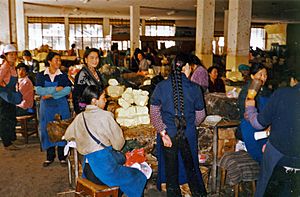
In 1997, India made the most butter, and most of it was eaten there. The United States, France, Germany, and New Zealand also produced a lot of butter. France eats the most butter per person each year. New Zealand, Australia, and Ukraine export a lot of the butter they make.
Different kinds of butter are found worldwide. Smen is a spiced clarified butter from Morocco. It is buried and aged for months or years. Yak butter is special in Tibet. Tsampa, a food made from barley flour mixed with yak butter, is a main food there. Butter tea is drunk in the Himalayan regions. It is tea with strong-flavored yak butter and salt. In some parts of Africa and Asia, butter is made from sour milk instead of cream.
Here are the top butter-producing countries in 2018:
| Country | Production, 2018 (tonnes) |
|||
|---|---|---|---|---|
| 1 | 892,801 | |||
| 2 | 502,000 | |||
| 3 | 484,047 | |||
| 4 | 352,400 | |||
| 5 | 257,883 | |||
| 6 | 237,800 | |||
| 7 | 215,431 | |||
| 8 | 183,125 | |||
| 9 | 177,260 | |||
| 10 | 153,674 | |||
| 11 | 152,000 | |||
| 12 | 116,144 | |||
| 13 | 115,199 | |||
| 14 | 109,100 | |||
| 15 | 100,000 | |||
| Source : FAOSTAT | ||||
Storing Butter
Regular butter becomes soft enough to spread around 15 degrees Celsius (60 degrees Fahrenheit). This is warmer than most refrigerators. The "butter compartment" in many refrigerators is a bit warmer than the rest, but butter can still be quite hard. Keeping butter tightly wrapped helps it last longer. This is because light and air make it go bad faster. It also stops butter from picking up other smells. Wrapped butter can last several months in the refrigerator. You can also freeze butter to store it for even longer.
"French butter dishes" or "Acadian butter dishes" are special containers. They have a lid with a rim that sits in a small amount of water. Butter is packed into the lid. The water creates a seal that keeps the butter fresh. It also stops the butter from getting too warm. This way, butter can stay on a counter for several days without spoiling.
Butter in Cooking
Butter is very important in French cuisine. Many chefs say they need lots of butter! Julia Child famously said, "With enough butter, anything is good."
Once butter is soft, you can mix in spices, herbs, or other flavors. This makes a compound butter. Compound butters can be used as spreads or melted over hot food as a sauce. Sweet compound butters can be served with desserts.
Melted butter is key in many sauces. Beurre noisette (hazelnut butter) and Beurre noir (black butter) are sauces of melted butter cooked until the milk solids turn golden or dark brown. They are often finished with vinegar or lemon juice. Hollandaise and béarnaise sauces are made from egg yolk and melted butter. They are like mayonnaise but with butter instead of oil.
In Poland, the butter lamb (Baranek wielkanocny) is a traditional part of the Easter meal. Butter is shaped into a lamb, by hand or using a mold. Butter is also used to make edible decorations for other dishes.
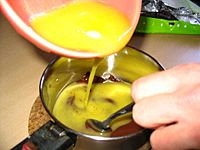
Butter is used for sautéing and frying. However, its milk solids can burn easily above 150 degrees Celsius (250 degrees Fahrenheit). Clarified butter or ghee are better for frying because they have a higher smoke point. Ghee has always been a common frying fat in India.
Butter plays several roles in baking. It is used like other solid fats such as lard or shortening. But butter adds a flavor that goes well with sweet baked goods. Many cookie doughs and some cake batters are made light and airy by mixing butter and sugar together. This process, called creaming, adds tiny air bubbles to the butter. These bubbles expand when baked, making the cookie or cake light. Buttercream is an icing made with creamed butter.
Butter and Your Health
| Type of fat | Total fat (g) | Saturated fat (g) | Monounsaturated fat (g) | Polyunsaturated fat (g) | Smoke point |
|---|---|---|---|---|---|
| Butter | 80-88 | 43-48 | 15-19 | 2-3 | 150 °C (302 °F) |
| Canola oil | 100 | 6-7 | 62-64 | 24-26 | 205 °C (401 °F) |
| Coconut oil | 99 | 83 | 6 | 2 | 177 °C (351 °F) |
| Corn oil | 100 | 13-14 | 27-29 | 52-54 | 230 °C (446 °F) |
| Lard | 100 | 39 | 45 | 11 | 190 °C (374 °F) |
| Peanut oil | 100 | 17 | 46 | 32 | 225 °C (437 °F) |
| Olive oil | 100 | 13-19 | 59-74 | 6-16 | 190 °C (374 °F) |
| Rice bran oil | 100 | 25 | 38 | 37 | 250 °C (482 °F) |
| Soybean oil | 100 | 15 | 22 | 57-58 | 257 °C (495 °F) |
| Suet | 94 | 52 | 32 | 3 | 200 °C (392 °F) |
| Ghee | 99 | 62 | 29 | 4 | 204 °C (399 °F) |
| Sunflower oil | 100 | 10 | 20 | 66 | 225 °C (437 °F) |
| Sunflower oil (high oleic) | 100 | 12 | 84 | 4 | |
| Vegetable shortening | 100 | 25 | 41 | 28 | 165 °C (329 °F) |
Butter is mostly milk fat, so it has only tiny amounts of lactose. This means that people who are lactose intolerant can usually eat moderate amounts of butter. However, people with milk allergies might still need to avoid butter. This is because it contains enough allergy-causing proteins to cause a reaction. Whole milk, butter, and cream have high levels of saturated fat. Butter is a good source of Vitamin A.
Some studies have looked at how butter affects health. A study in 2016 found that butter had only a small or neutral effect on serious health issues like heart disease and diabetes. The study suggested that dietary guidelines do not need to focus a lot on increasing or decreasing butter consumption.
See also
 In Spanish: Mantequilla para niños
In Spanish: Mantequilla para niños


